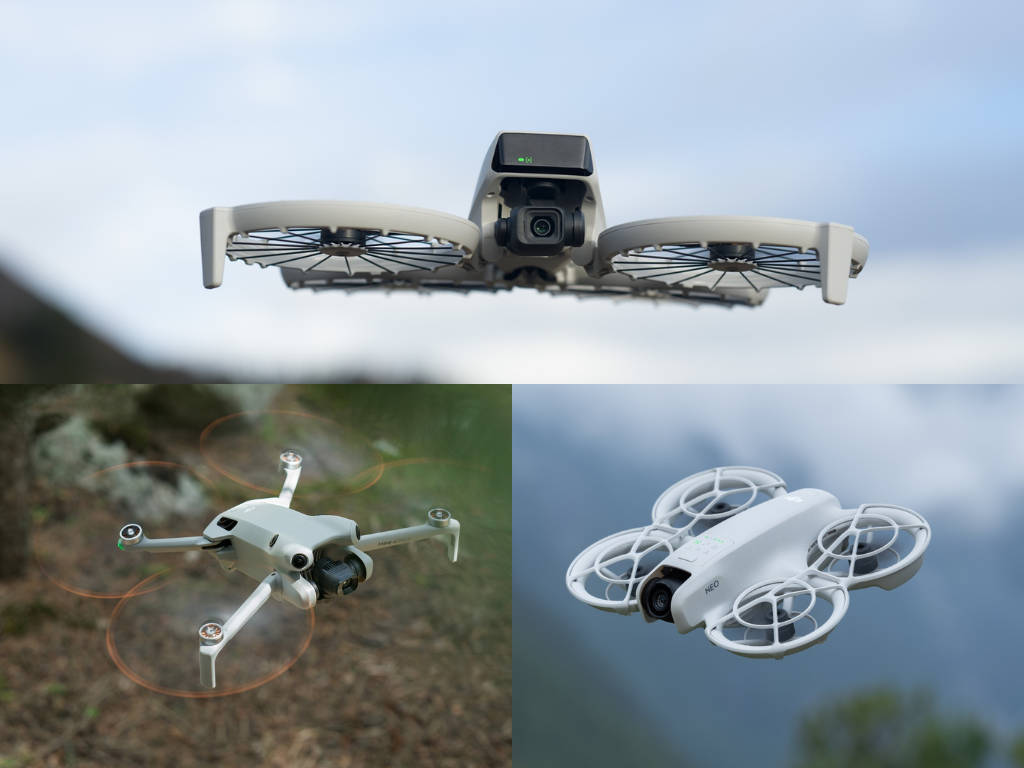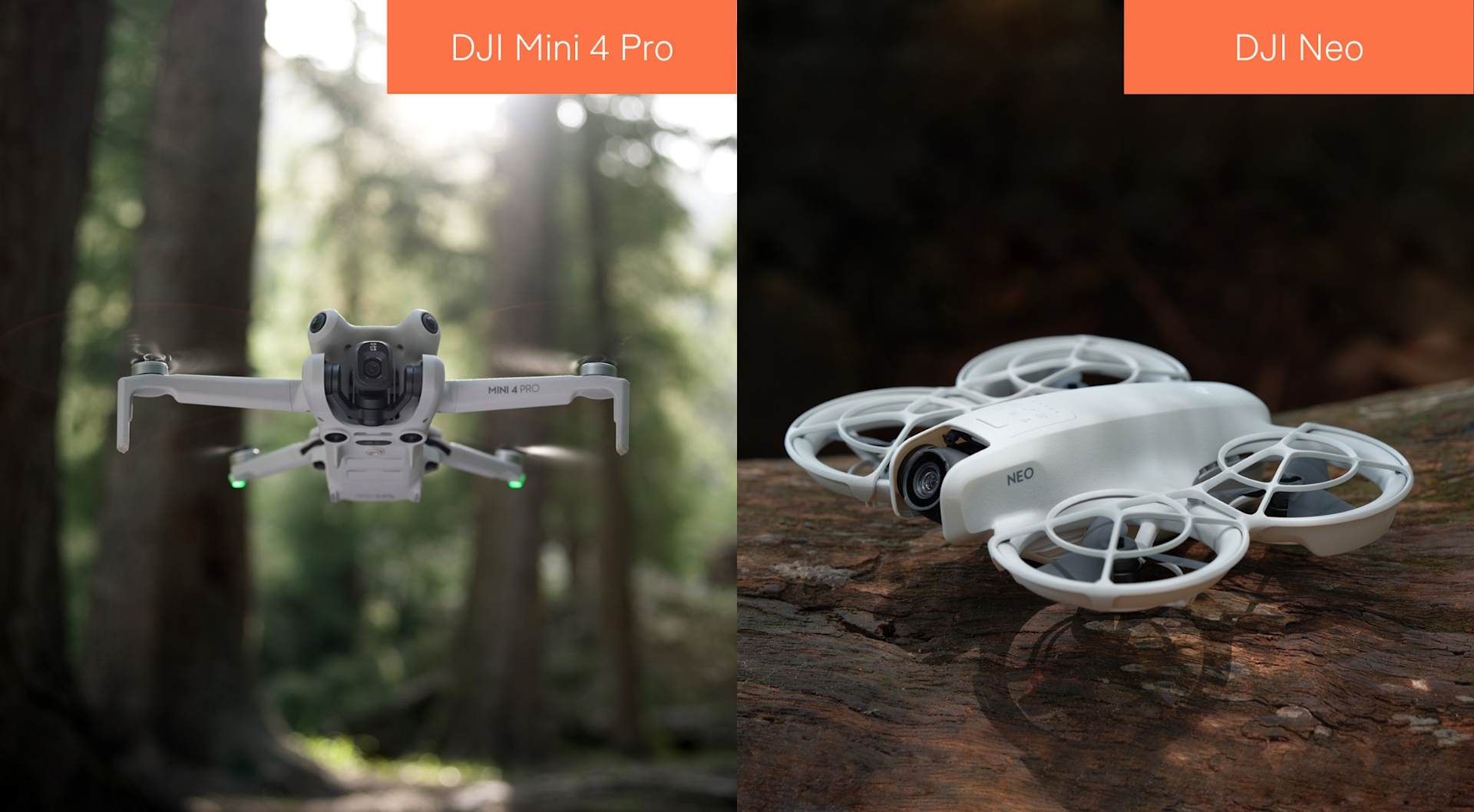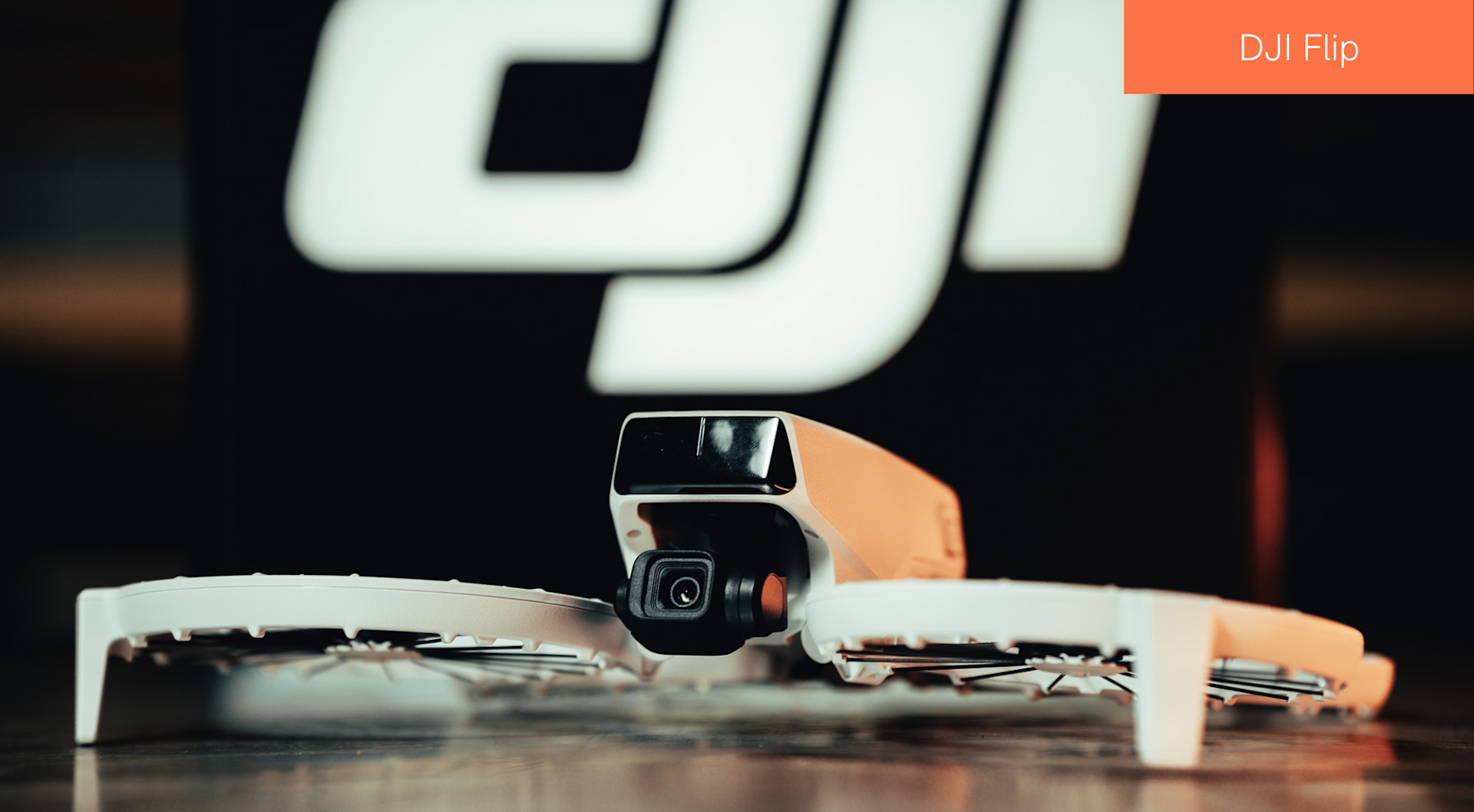
Products
Published on 14 Jan 2025
James Willoughby
DJI Flip vs DJI Neo vs DJI Mini 4 Pro
In-depth comparison between DJI Flip, DJI Neo, and DJI Mini 4 Pro. Find out which compact camera drone is best for your needs.
Comparison between DJI Flip, DJI Neo, and DJI Mini 4 Pro;
The Flip is DJI's newest drone to the market - featuring AI subject tracking and a foldable full-coverage propeller guard design;
Find out which compact 4K camera drone is best for you.
DJI Flip is here: So let the battle of the mini drones commence!
This exciting entry to the market is stacked with an abundance of features, including AI subject tracking, palm take-off, a foldable full-coverage prop guard design, and a belting camera offering 4K/60fps HDR video.

Its performance capabilities coupled with its compact sub-250g design make the Flip something of a hybrid - with a sprinkling of the DJI Neo combined with a touch of the DJI Mini 4 Pro.

So, with the Flip taking inspiration from these two popular platforms - and with some exclusive, eye-opening features to boot - how does it compare?
Is it worth adding to your line-up if you already own a Mini and/or a Neo? Or, if you're new to the game and in the market for a small camera drone, which one of these teeny-tiny aircraft is best for you?
Find out in our in-depth comparison article.
DJI Flip vs DJI Neo vs DJI Mini 4 Pro: Key specs at a glance
Before we delve into the features of each drone in more detail, let's take an at-a-glance look at what the DJI Flip, Neo, and Mini 4 Pro have to offer.
DJI Flip | DJI Neo | DJI Mini 4 Pro | |
|---|---|---|---|
Weight | <249g | 135g | <249g |
Built-in prop guards | Yes | Yes | No |
Camera | 1/1.3-inch sensor 4K/60fps HDR Video and 4K/100fps slow motion 12MP/48MP images | 1/2-inch image sensor 4K/30fps UHD video 12MP images | 1/1.3-inch image sensor 4K/60fps HDR video and 4K/100fps slow motion 12MP/48MP images |
Vertical video | Yes | Yes | Yes |
Zoom | Digital zoom: Up to 4x | No | Digital zoom: Up to 4x |
Flight time | 31 minutes | 18 minutes | 34 minutes |
Palm take-off | Yes | Yes | No |
Voice control | Yes | Yes | No |
Operating temperature | -10°C to 40°C | -10°C to 40°C | -10°C to 40°C |
Wind speed resistance | 10.7 m/s | 8 m/s | 10.7 m/s |
Transmission (CE) | DJI O4 8km | DJI O4 6km | DJI O4 10km |
Storage | 2 GB internal storage Supports up to 512 GB external microSD card | 22 GB internal storage No support for external SD card | 2 GB internal storage Supports up to 512 GB external microSD card |
Price (correct as of January 14, 2025, at the launch of DJI Flip) | DJI Flip (RC-N3): £369 DJI Flip (DJI RC 2): £549 DJI Flip Fly More Combo with DJI RC 2: £659 | DJI Neo (No RC): £169 DJI Neo Fly More Combo: £299 DJI Neo Motion Fly More Combo: £449 | DJI Mini 4 Pro (RC-N2): £659.96 DJI Mini 4 Pro (RC 2): £862 DJI Mini 4 Pro with RC-2 (Fly More Combo): £960.65 |
DJI Flip vs DJI Neo vs DJI Mini 4 Pro: Design
All three platforms are lightweight, compact, and ultra-portable - making them ideal travel companions.
The Neo is the lightest of the three, weighing 135g, while DJI Flip and Mini 4 Pro come in at just under 250g.

These weights place the trio within the safest drone category and, as such, they don't require official training with the UK CAA.
It means operators can take to the skies without having to obtain permissions or undergo training, such as the A2 CofC - although heliguy™ does advise taking this to bolster pilot competency - and have a vast amount of freedom during flights (operate in A1 subcategory - fly over uninvolved people, but not crowds).
When it comes to appearance, the Flip is DJI's first drone equipped with an innovative foldable full-coverage propeller guard design. And it has to be said, the ability to fold-down the drone makes the Flip look super cool and is an eye-catching design feature.
The drone also turns on when the props are folded out, and off again when the propellers ae folded back in.
The foldable frame is great for portability. But crucially, having built-in prop guards helps to increase safety during flight - making it especially suited to first-time pilots.

The Neo isn't foldable, but comes with propeller guards. The Mini 4 Pro has foldable arms. It does not come with propeller guards, but these are available separately.
However, it is worth saying that adding prop guards to the Mini 4 Pro will push it over its sub 250g weight - removing some of the flight freedoms associated with sub 250g drones.
In this case, a Mini 4 Pro, with prop guards, weighing between 250g and 500g, could be flown in the A1 subcategory (with the stipulation of no intentional flights over uninvolved people) - but the pilot must have an A2 CofC training certificate. If the pilot does not have an A2 CofC, then flights would be restricted to the A3 subcategory (no uninvolved people within the area of flight and no flights within 150m horizontally of residential, commercial, industrial, or recreational areas).
A look at all three drones also shows another key difference: The Flip and Mini 4 Pro have a microSD card slot, providing the option to increase memory (up to 512 GB) over and above the 2GB of on-board storage. In contrast, the Neo does not have a microSD port, limiting users to the 22GB of storage on the aircraft.
DJI Flip | DJI Neo | DJI Mini 4 Pro | |
|---|---|---|---|
Takeoff weight | < 249 g | Approx. 135 g | < 249 g |
Dimensions (L x W x H) | Folded: 136 x 62 x 165 mm Unfolded: 233 x 280 x 79 mm | 130 x 157 x 48.5 mm | Folded (without propellers): 148 x 94 x 64 mm Unfolded (with propellers): 298 x 373 x 101 mm |
DJI Flip vs DJI Neo vs DJI Mini 4 Pro: Camera
The capability of the camera is a key consideration when comparing the three drones.
In a nutshell, the DJI Flip and DJI Mini 4 Pro come out on top - with essentially the same sensor, packing plenty of image quality into their tiny frames.

The Flip and Mini 4 Pro are equipped with a 1/1.3-inch image sensor capable of 48MP/12MP imagery, while the Neo has a smaller 1/2-inch sensor with 12MP imaging capabilities.
When it comes to video, the Flip and Mini 4 Pro can shoot 4K/60fps HDR video, and 4K/100fps slow-motion. The Neo tops out at 4K/30fps.
All three drones can also capture vertical videos - ideal for creating social-media-ready content. To do this, the Mini 4 Pro's gimbal actually rotates to enable you to capture true vertical content. This enables the Mini to shoot vertically at 4K/60fps.
The DJI Flip and Neo don't have rotating gimbals: Instead, this is offered by cropping the image vertically. The result: Flip shoots 2.7k vertical video, while the Neo - courtesy of a firmware update to enable vertical content - can obtain 1080p at 30fps.

Both the Flip and Mini 4 Pro benefit from up to 4x zoom, while the Neo does not have zoom functionality.
On top of this, the Flip and Mini 4 Pro are equipped with 10-bit D Log M, which supports recording up to one billion colours and helps retain more highlight and shadow details for increased flexibility when editing.
The table below provides an overview of the drones' key camera specifications.
DJI Flip | DJI Neo | DJI Mini 4 Pro | |
|---|---|---|---|
Image Sensor | 1/1.3-inch image sensor 12MP/48MP | 1/2-inch image sensor 12 MP | 1/1.3-inch CMOS 12MP/48MP |
Lens | FOV: 82.1° Format Equivalent: 24 mm Aperture: f/1.7 Focus: 1 m to ∞ | FOV: 117.6° Format Equivalent: 14 mm Aperture: f/2.8 Focus: 0.6 m to ∞ | FOV: 82.1° Format Equivalent: 24 mm Aperture: f/1.7 Focus: 1 m to ∞ |
ISO Range | Video Normal/Slow Motion: 100-6400 (Normal) 100-1600 (D-Log M) Photo 12MP Photo: 100-6400 48MP Photo: 100-3200 | 100-6400 (Auto) 100-6400 (Manual) | Video Normal and Slow Motion: 100-6400 (Normal) 100-1600 (D-Log M) 100-1600 (HLG) Night: 100-12800 (Normal) Photo 12 MP: 100-6400 48 MP: 100-3200 |
Shutter Speed | 12MP Photo: 1/16000-2 s (2.5-8 s for simulated long exposure) 48MP Photo: 1/8000-2 s | Video: 1/8000-1/30 s Photo: 1/8000-1/10 s | 12MP Photo: 1/16000-2 s (2.5-8 s for simulated long exposure) 48MP Photo: 1/8000-2 s |
Max Image Size | 48MP Photo 8064 x 6048 | 12 MP Photo 4000×3000 (4∶3) 4000×2256 (16∶9) | 8064 x 6048 |
Still Photography Modes | Single Shot: 12 MP and 48 MP Burst Shooting: 12 MP, 3/5/7 frames Automatic Exposure Bracketing (AEB): 12 MP, 3/5/7 frames at 2/3 EV step Timed: 12 MP, 2 / 3 / 5 / 7 / 10 / 15 / 20 / 30 / 60 s | Single/Timed Shot | Single Shot: 12 MP and 48 MP Burst Shooting: 12 MP, 3/5/7 frames 48 MP, 3/5 frames Automatic Exposure Bracketing (AEB): 12 MP, 3/5/7 frames at 0.7 EV step 48 MP, 3/5 frames at 0.7 EV step Timed: 12 MP, 2 / 3 / 5 / 7 / 10 / 15 / 20 / 30 /60 s 48 MP, 5 / 7 / 10 / 15 / 20 / 30 / 60 s |
Photo Format | JPEG DNG/RAW | JPEG | JPEG DNG (RAW) |
Video Resolution | 4K: 3840 x 2160 @ 24/25/30/48/50/60fps FHD: 1920 x 1080 @ 24/25/30/48/50/60/100fps 2.7K Vertical Shooting: 1512 x 2688@24/25/30fp FHD Vertical Shooting: 1080 x 1920 @ 24/25/30fps | EIS Off: 4K (4:3): 3840 x 2880 @ 30fps 1080p (4:3): 1440 x 1080 @ 60/50/30fp EIS On: 4K (16:9): 3840 x 2160 @ 30fps 1080p (16:9): 1920 x 1080 @ 60/50/30fp Vertical Shooting 1080p (9:16) 1080×1920@60/50/30fps | H.264/H.265 4K: 3840 × 2160 @ 24/25/30/48/50/60/100*fps FHD: 1920 × 1080 @ 24/25/30/48/50/60/100*/200*fps *slow motion. 4K/100fps and HLG/D-Log M only support H.265 coding. |
Video Format | MP4 | MP4 | MP4 (MPEG-4 AVC/H.264, HEVC/H.265) |
Max Video Bitrate | 150 Mbps | 75Mbps | H.264/H.265: 150 Mbps |
Supported File System | exFAT | exFAT | exFAT |
Colour Mode | Normal 10-bit D-Log M | Normal | Normal: 8-bit 4:2:0 (H.264/H.265) HLG/D-Log M: 10-bit 4:2:0 (H.265) |
Digital Zoom | 4K: 3x FHD: 4x 2.7K Vertical Shooting: 3x FHD Vertical Shooting: 4x 12 MP Photo: 3x | - | 12MP Photo: 1-3x 4K: 1-3x FHD: 1-4x |
DJI Flip vs DJI Neo vs DJI Mini 4 Pro: Performance
All three drones pack plenty of performance into their small frames - although pilots can squeeze out more with the Flip and Mini 4 Pro, compared to the Neo.
For instance, the Neo is capable of up to 18 minutes of airtime, but the Flip stretches this to 31 minutes. The Mini 4 Pro can go further still, with a maximum flight time of 34 minutes.

When it comes to handling the weather, this drone trio can operate in temperatures from -10° to 40°C. However, when battling windy conditions, the Flip and Mini 4 Pro have the edge, withstanding Level 5 speeds of 10.7 m/s, while the Neo tops out at a Level 4 wind speed of 8 m/s.
None of the drones are IP-rated, so we'd advise against flying them in the rain.
The Mini 4 Pro and the Flip are more agile than the Neo, while Flip sits between the Mini 4 Pro and Neo for speed in sport mode.
DJI Flip | DJI Neo | DJI Mini 4 Pro | |
|---|---|---|---|
Max flight time | 31 minutes | 18 mins (approx. 17 mins with the propeller guards) | 34 minutes |
Max horizontal speed (near sea level, no wind) | 12 m/s (Sport mode) | 8 m/s (Sport mode) 6 m/s (Normal mode) 16 m/s (Manual mode) | 16 m/s (Sport Mode) 12 m/s (Normal Mode) 12 m/s (Cine Mode) |
Max ascent speed | 5 m/s (Sport mode) 5 m/s (Normal mode) 2 m/s (Cine mode) | 3 m/s (Sport mode) 2 m/s (Normal mode) 0.5 m/s (Cine mode) | 5 m/s (Sport Mode) 5 m/s (Normal Mode) 3 m/s (Cine Mode) |
Max descent speed | 5 m/s (Sport mode) 5 m/s (Normal mode) 1.5 m/s (Cine mode) | 0.5 m/s (Cine mode) 2 m/s (Normal mode) 2 m/s (Sport mode) | 5 m/s (S Mode) 5 m/s (N Mode) 3 m/s (C Mode) |
Max takeoff altitude | 3000 m | 2000 m | 4000 m |
Max flight distance | 14 km | 7 km | 18 km |
Max wind speed resistance | 10.7 m/s | 8 m/s | 10.7 m/s |
Operating temperature | -10° to 40°C | -10° to 40°C | -10° to 40°C |
DJI Flip vs DJI Neo vs DJI Mini 4 Pro: Intelligent Modes
The DJI Flip, DJI Neo, and DJI Mini 4 Pro are packed with intelligent modes and features, helping pilots capture stunning content and streamline flying.
Intelligent shooting modes
All three aircraft offer a range of intelligent shooting modes, providing dynamic angles to elevate your creative footage, while Mini 4 Pro and Flip also enable Hyperlapse, FocusTrack, and Panorama.
Control methods
The Flip and Neo support multiple control modes - including the ability to fly without a controller.

These control methods include palm control (using the Mode button on the drone to switch between shooting modes), mobile app control (using virtual joysticks in DJI Fly app on your phone), voice control, and remote controller control.
In contrast, the Mini 4 Pro is limited to a more traditional RC control experience.
However, both the Mini 4 Pro and Neo can be used with the DJI FPV ecosystem - including goggles and motion controllers to control the drone by your hand movements - to enable immersive first-person view flights.
Currently, Flip cannot be used in an FPV format, even though it seems perfect for this type of flight. It remains to be seen if this will change in a firmware update post-launch.
Subject tracking
DJI Flip, Neo, and Mini 4 Pro enable subject tracking.
Flip and Neo utilise AI subject tracking to help you quickly and accurately keep your subject in the spotlight. Meanwhile, the DJI Mini 4 Pro is equipped with the sophisticated ActiveTrack 360°.
DJI Flip vs DJI Neo vs DJI Mini 4 Pro: Safety
The addition of the propeller guards provides an extra layer of flight safety with the DJI Flip and DJI Neo - and the foldable prop guard design of the Flip is one of the product's headline features.

As mentioned previously, the Mini 4 Pro can be deployed with propeller guards, which are available to purchase separately, but this would impact flight freedom due to the drone going over the sub 250g threshold.
However, for flight safety, the Mini 4 Pro features additional on-board sensing, with an omnidirectional vision system, 3D infrared sensing system on the bottom of the aircraft, a downward vision system, and an auxiliary light.
In contrast, the Neo has an infrared sensing system and a downward vision system.
The Flip sits between the two, with more onboard safety features compared to the Neo, but less than the Mini. It is equipped with a forward 3D infrared sensing system, a downward infrared imaging system, and a downward vision system. The Flip's 3D ToF sensors enable automatic braking, even at night!
DJI Flip | DJI Neo | DJI Mini 4 Pro | |
|---|---|---|---|
Sensing | Downward: One visual sensor and an infrared sensor. Forward: 3D Infrared Sensing System | Downward visual positioning | Omnidirectional binocular vision system, supplemented with a 3D infrared sensor at the bottom of the aircraft |
DJI Flip vs DJI Neo vs DJI Mini 4 Pro: Transmission
All three drones utilise the DJI O4 transmission system and offer a live view quality of up to 1080p/60fps.
The Mini 4 Pro affords a 10km transmission range (CE), compared to the Flip's 8km and the Neo's 6km.
DJI Flip | DJI Neo | DJI Mini 4 Pro | |
|---|---|---|---|
Video transmission system | O4 | O4 | O4 |
Live view quality | Remote Controller: Up to 1080p/60fps | With DJI RC-N3 Remote Controller: Up to 1080p/60fps With DJI Goggles 3 plus DJI RC Motion 3/DJI FPV Remote Controller 3: Up to 1080p/60fps | Remote Controller: Up to 1080p/60fps (available when the aircraft is flying in Photo or Video mode) Up to 1080p/30fps (available when the aircraft is flying in Video mode) Up to 1080p/24fps (available when the aircraft is in standby mode on the ground) |
Max transmission distance (CE) | 8 km | 6 km | 10 km |
Max download speed | O4: DJI RC-N3 Remote Controller: 10 MB/s; DJI RC: 10 MB/s Wi-Fi 5: 30 MB/s | Wi-Fi: 25 MB/s | O4: 10 MB/s (with DJI RC-N2) 10 MB/s (with DJI RC 2) Wi-Fi 5: 30 MB/s |
Lowest latency | Approx 120ms | With DJI RC-N3 Remote Controller: Approx. 120 ms | Aircraft + Remote Controller: Approx. 120 ms |
Antennas | 4 antennas | 2 antennas | 4 antennas |
DJI Flip vs DJI Neo vs DJI Mini 4 Pro: Remote controller compatibility
As mentioned previously, the Flip and Neo can be flown without a controller.
However, they can be used with an RC.
The Flip, Neo, and Mini 4 Pro are compatible with DJI's latest consumer controllers: The DJI RC-N3 - which requires a separate mobile device - and the DJI RC 2 smart controller with built-in screen.

Using a smart controller offers several benefits, including a FHD screen that can handle bright sunlight, in-built storage capacity, and the flight app installed to save space on your mobile phone.
The RC 2 offers:
Attribute | Specification |
|---|---|
Resolution | 1920 x 1080 |
Screen size | 5.5 inches |
Frame rate | 60fps |
Brightness | 700 nits |
Storage capacity | 32GB + expandable storage (with microSD card) |
Operating time | 3 hours |
Charging time | 1.5 hours (with 9V/3A charger) |
Operating temperature | -10° to 40° C |
Weight | Approx. 420 g |
Meanwhile, the DJI RC-N3 offers:
Attribute | Specification |
|---|---|
Weight | 320 g |
Max supported mobile device size (L x W x H) | 180 x 86 x 10 mm |
Max operating time | 3.5 hours 1.5 hours when charging a mobile device |
Charging time | 2 hours |
Operating temperature | -10° to 40°C |
Flip, Neo, and the Mini 4 Pro are also all compatible with the older generation DJI RC-N2 remote controller, which requires a separate smart device.
As covered earlier, the DJI Neo and DJI Mini 4 Pro are part of the FPV ecosystem. At launch, the Flip does not appear to support FPV flight, but this could change in the future.
Price
There is a clear price difference between the DJI Flip, Neo, and Mini 4 Pro - and this may help decide which drone is best for you.
The Neo is at the most cost-effective end of the spectrum, ranging from £169 to £449, depending on the package you go for.
On the other side of the scale is the Mini 4 Pro, which works out as the most expensive of the three, with the most pricey option - the Fly More Combo with RC 2 controller - pushing close to the £1,000 mark.
Nestled in the middle is DJI Flip, with packages ranging from £369 to £659 at launch.

DJI Flip vs DJI Neo vs DJI Mini 4 Pro: Summary
When it comes to mini drones, DJI has been at the forefront of innovation, and the DJI Flip is yet another exciting addition to the compact UAS market.
This hybrid platform takes inspiration from the Neo and Mini 4 Pro: Blending the Neo's palm and voice control modes and built-in propeller guards with the Mini 4 Pro's performance specs, including quality imaging capabilities and enhanced flight time.
Merging key features of the Neo and Mini 4 Pro results in the Flip being an exciting addition to the market - and that folding propeller guard design is a true headline grabber.
It's fair to say that the Flip is something of an upgrade from the Neo, offering better flight time and camera specs among other things - but currently lacking FPV mode; while it offers a quirky alternative to the Mini 4 Pro, matching many of its performance specs, but with a more cost-effective price tag.
To buy DJI Flip, click here, or contact heliguy™.
